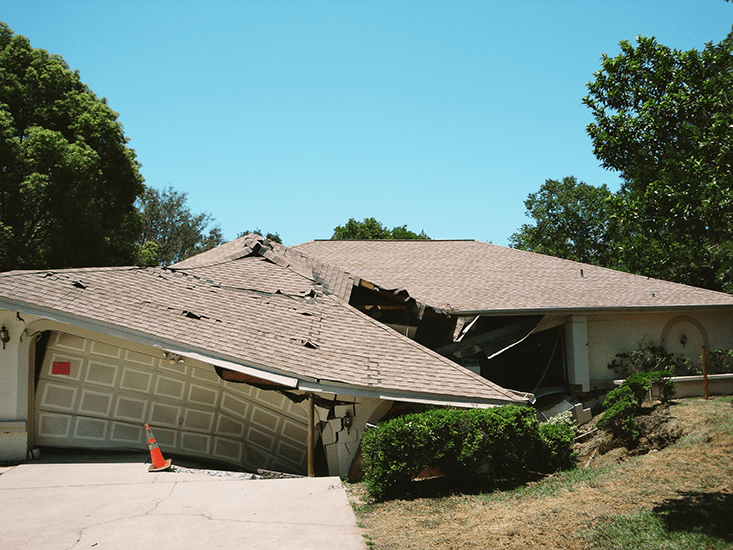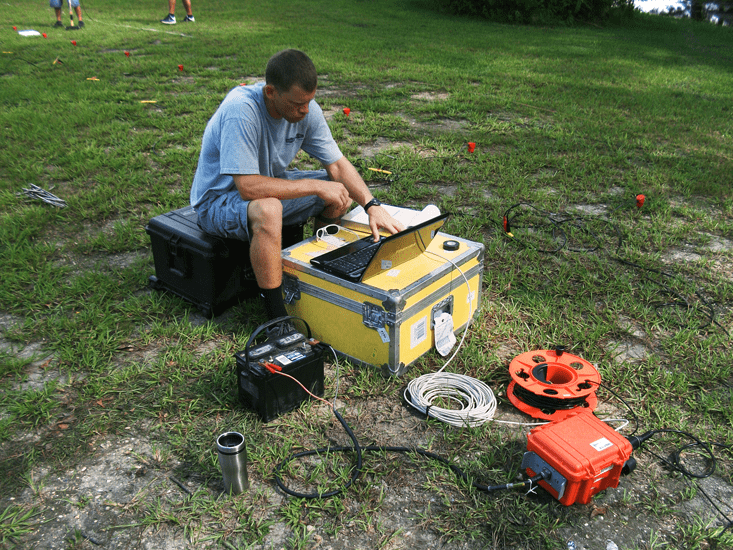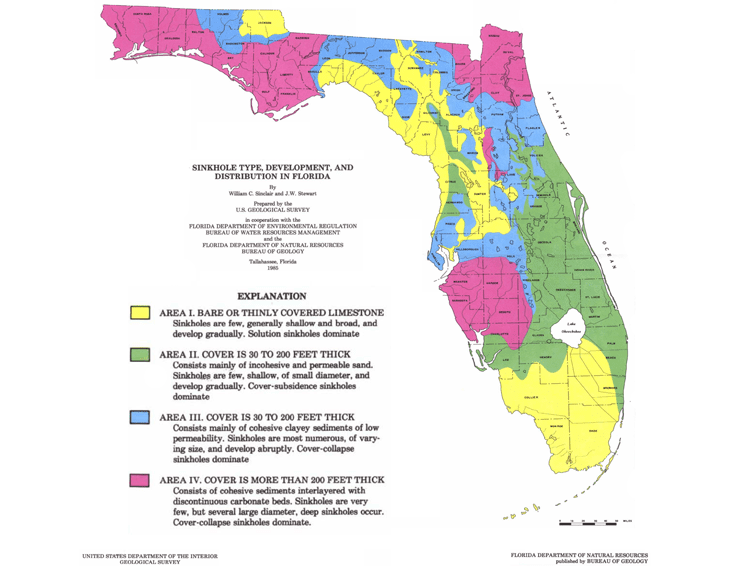One day last May, a muddy truck bound down a dirt road through the backwoods of Gainesville, Florida. It pulled up in a cloud of dust to a sprawling green farmhouse with a wide front porch, nestled among cypress trees dripping in gray Spanish moss. Horses ate from hay bales in a small stable. Situated on four acres of pasture and woods, the house was a place to spend a day in a rocking chair, sipping from a tall cold glass of sweet tea. But the owner, Bill Baxter, a graying, retired hospital administrator with a thick Southern accent, was sweating, and not because of the heat.
Baxter guided the men in the truck through his backyard and told them of the scare he’d had the other day. Abbot, his snow white 10-year-old horse, was wandering along the front lawn of the house. As the horse walked near the knotty old oak tree in the center of the yard, the earth beneath his right front hoof softened and gave way. Baxter ran from the porch of his house and freed Abbot’s hoof from the fresh hole. He gazed down into the narrow deep darkness that remained below. “This is suspicious,” Baxter thought.
He had reason to be wary. A few feet away lurked a pool-sized crater of fallen earth that was growing bigger by the year. It was a sinkhole, just one of thousands pockmarking the state, and now, Baxter feared, it was threatening to take his horses and him and his wife with it. “If this is getting worse,” he said, “how safe can it be in the house?”
“Last time I checked, the constitution lets you move where you want to move. You don’t cut back on growth.”
Baxter’s home is on ground zero of sinkhole country, an area so besieged it’s earned the ominous nickname Sinkhole Alley. While sinkholes dot the globe, Florida is uniquely vulnerable. The state sits on fragile karst terrain formed from the dissolution of soluble bedrock such as limestone, dolomite, and gypsum. Florida suffers from two main culprits causing the sinkholes: the heavy rains pounding the surface and the rampant development upsetting the aquifer.
According to Jon Arthur, Florida State Geologist, there are tens of thousands of sinkholes in the state. And sinkhole claims have tripled since 2006. Just before my visit, three sinkholes swallowed up one street of mobile homes. Last year alone, there were 3,400 reported sinkholes in the United States, 700 of them in Florida. Geologists and geophysicists are racing to predict where sinkholes might strike next, if and when they can. So when Baxter gazed into the hole Abbot left, he did the one and only thing he could—he called the sinkhole hunters.
The men were from Geohazards, a scrappy company of scientists and engineers based in the college town of Gainesville. They get hired by anxious residents like Baxter, corporate builders, and insurance companies to investigate existing sinkholes and anticipate new ones. Using the latest tools and technologies to test for subsurface anomalies, they storm in the wilds of Florida to try to divine the threats brewing underground.
But they’re not just battling Mother Nature, they’re battling something even more determined: the ever-expanding developers and eager homeowners moving to the country’s third most populous state. (The state gained 293,000 people between 2013 and 2014, or 803 people per day). The expansion of roads and parking lots affects the likelihood of sinkholes. “The more footprint we occupy on land that was previously native land or unoccupied, the more likely we are to encourage areas that are more prone to sinkholes,” says Arthur.
Not that builders are about to turn back the tractors. “Last time I checked, the constitution lets you move where you want to move,” Douglas Buck, the director of government affairs for the Florida Home Builders Association, tells me, curtly. “You don’t cut back on growth.”
As the geologists gazed into Baxter’s pit, it was a haunting reminder of how difficult it is for scientists like them to predict when a sinkhole will hit. “It could take hundreds or thousands of years,” Anthony Randazzo, a tanned, brash 70-year-old from Staten Island, who co-founded Geohazards, tells me. “Or it could be next week.”

When you grow up in Sinkhole Alley, like I did, it’s kind of like growing up on the set of a sci-fi B movie. As a kid in Tampa, we got used to hearing about the latest Attack of a Giant Hole in the Earth. They could hit anywhere, anytime, opening out of the ground to swallow whatever—or whomever—was unfortunate enough to be in their way. There were sinkholes in the woods, sinkholes in the playgrounds, sinkholes filled with trash, sinkholes filled with water and gunk, teeming with gators. The second we heard of a new sinkhole opening up, we’d hop on our dirt bikes and pedal as quickly as we could to see the maw.
When I visit the Geohazards office, I see an impressive gallery of destruction. Hanging in the hallway, there’s a framed photo of a delivery truck dangling precipitously over the edge of a parking lot pit. A huge pit with a house and cars inside, like the toys of a giant’s sandbox. But the most dramatic one of all shows an aerial shot of the state’s most famous and foreboding sinkhole of all in Winter Park, Florida: 350 feet wide, 75 feet deep, and known, as the former state geologist put it at the time, as “the largest sinkhole event ever witnessed.”
It happened on May 8, 1981, a few hours after a local resident, Mae Rose Owens, heard what she later described to be a “queer, swishing” sound outside. Over the next several hours, the earth opened up beneath the neighborhood, devouring Owens’ home, along with a swimming pool, the nearby streets, and five Porsches at an auto body shop. Today, the sinkhole, which caused $4 million in damages, is a pristine lake. But for geologist Randazzo and geophysicist Douglas Smith, professors emeritus of geological sciences at the University of Florida and co-founders of Geohazards, it’s a sign of the challenges they face: the vulnerable ground below, and the ambitious builders above.
According to the United States Geological Survey, karst underlies about 15 percent of the continental U.S., but sits underneath 40 percent of the Eastern seaboard. While other rocks are gradually worn away by wind and weather, karst terrain erodes in even slightly acidic rainfall. Instead of running off into streams or rivers, the rain water eats into the bedrock, forming a lattice of cracks, pores, and, eventually, caves. As the near surface limestone erodes, the water flows into the formation of springs. Sometimes, the surface remains thin but intact, and the water recedes into the deeper crevices of the bedrock, leaving an empty cavern ready to subsume the land above when it finally gives way: a sinkhole.
He ran down the hall to find something out of a science-fiction movie: a sinkhole that had just swallowed his brother.
Sinkholes emerge in two varieties, slow or fast. The slower ones, called “cover subsidence sinkholes,” ravel into themselves gradually, “like grains of sand in an hourglass,” as Smith, a steely 70-year-old, puts it. The more dramatic forms, called “cover collapse sinkholes,” are of the Winter Park type: occurring within days or even hours after the surface caves in.
Of all the karst terrain, Florida is uniquely susceptible to sinkholes because of its heavy rainfall and years of ocean wash. The thin layer of marine sand and clay covering the bedrock is especially permeable, leaving the limestone underneath even more vulnerable and exposed to dissolution. The oldest limestone, and that which has been eroding the longest, runs along the vein of Interstate 4, which cuts from Tampa northeast up to Daytona. Younger limestone, such as the bedrock under Miami, is less susceptible. “One-hundred-thousand-year-old limestone is recent in our lingo,” says Randazzo, “compared to the 40 million year old limestone here in Gainesville.”
Florida’s wet weather makes a petri dish for the problem. It’s what Randazzo calls “sinkhole weather”—extensive periods of time with little rainfall, followed by a major storm. During the droughts, the water table drops, weakening sediment layers. When a rapid downpour hits, the sudden weight on the vulnerable sediment can trigger a collapse. Tropical storm Debby in June 2012 brought heavy rains after a dry spell, leaving hundreds of new sinkholes Swiss-cheesing the state.
But Florida has more than just its natural terrain with which to contend. Florida and its 20 million residents are putting a terrific strain on the fragile bedrock underneath. The problem comes from continuously tapping the aquifer, and compromising the limestone underneath. Every lawn that’s watered or pool that’s filled threatens to destabilize the karst. “They draw down the water table and it turns into a flushing toilet,” says Randall Orndorff, a geologist with the United States Geological Survey.
In normal conditions, precipitation hits the ground and the water percolates into the soil and rock below, causing natural groundwater formations. But when the ground is covered with impermeable surfaces—roads, houses, Walmarts—rainfall runs off into sewers and storm drains instead. “Hard surfaces—roofs, sidewalks, parking lots—all those things change the surface-water flow and may focus water into an area where there could be an unknown cavity and could cause collapse,” says Clint Kromhout, of the Florida Geological Survey.
Once new housing communities are built, the residents’ incessant pumping of water underneath only makes the problems worse. A recent study by the USGS concluded that long-term water pumping can lead to groundwater declines, “sometimes converting flowing springs to dry sinkholes.” With so many sinkholes forming, the challenge for scientists, such as those at Geohazards, is how to find them before they devour their next victim.
Among the sinkhole hunters in the state, Randazzo and Smith have been at this for longer than most. The two met while professors at the University of Florida in the 1970s. They realized that, as a geologist and geophysicist, respectively, they could combine their expertise in both understanding the karst terrain of Florida, and applying tools to help parse the potential threats. They weren’t the only ones concerned at the time. In 1972, Henry Swanson, an agricultural agent who oversaw citrus groves in the Orlando area, warned local mayors that rampant development—including plans for the nearby Disney World—would put the area at risk for sinkholes. (Nine years later, the Winter Park sinkhole struck, earning Swanson the nickname of Jeremiah.)
But it was one thing to warn of the problem, and another to develop the tools to locate the underground hazards. Late one sunny afternoon, I head out to Kanapaha Park in Gainesville with Geohazards’ team of engineers to see how they probe the earth for trouble below. Among the tools is what looks like a medium-sized orange lawnmower without wheels. But it’s actually a ground penetrating radar, capable of taking a picture of the underground. As the engineer drags the device over the ground, it emits electromagnetic pulses into the ground, which reflect back when they hit subsurface anomalies. When the data is transmitted onto a computer, it forms a map—like an X-ray—of the hidden terrain, including pockets of space that could indicate a sinkhole.
GPR provides a high resolution picture of the ground below, but has limited depth of penetration—roughly 15 to 25 feet. For greater depth (up to 100 feet below), but lower resolution, sinkhole hunters use a technique called electrical resistivity. This works by injecting an electrical current into the ground, which travels between a series of metal stakes, placed several feet apart. In the field where we stand, there are a couple dozen stakes heading off toward the trees, connected by a long yellow cable. As the electrical currents encounter anomalies underneath the surface, the resistance changes as well. The technology had been developed in the 1920s to look for metallic ore, but Smith was among the first geophysicists in Florida to apply it to sinkholes. When encountering a water-filled cavity, the currents will be lower in resistance and higher in conductivity.
During a typical investigation, the engineers will spend the first 40 minutes or so conducting the GPR test, followed by a roughly 90-minute evaluation using electrical resistivity. When data shows a well-developed cavity near the surface, suggesting threatening sinkhole activity, residents in the area will be evacuated as quickly as possible. For further confirmation, truck-mounted drill rigs are sent in to plumb down about 50 feet to 100 feet below. If the hammer ceases to advance more than a few inches with each blow, then the rock beneath the surface is considered hard and stable. The absence of resistance to the drill rod reveals a sinkhole cavity.

Newer and alternative techniques of finding sinkholes are emerging. In March, NASA revealed that its radar detected a giant sinkhole in Bayou Corne, Louisiana, one month before it collapsed in August 2012. NASA regularly monitors changes in the earth’s surface using airborne radar. While passing over the Bayou Corne area, NASA’s radar found that a surface area of the ground had moved around 10 inches toward the area where the two-acre sinkhole later caved in. “This kind of data could be of great value in determining the direction in which the sinkhole is likely to expand,” Cathleen Jones, a radar scientist at NASA’s Jet Propulsion Laboratory, said last year.
At the University of Central Florida in Orlando, engineers have been studying sinkhole formations by building simulations. Their process involved cutting open an oil drum, and filling it with soil, as well as PVC pipes with water and soil temperature monitoring sensors. Water is poured into the drum, simulating rainfall, as the sensors glean data on the shifting conditions in the ground.
In the best-case scenario, such testing can locate a sinkhole before the damage is done. But not every person or place is so lucky.
Geologist Drew Glasbrenner will never forget the phone call. It was late on Feb. 28, 2013, and Glasbrenner, who worked for an emergency response engineering team in Tampa, Florida, called Bracken Engineering, was dispatched to assist at a home that had just collapsed.
By the time Glasbrenner arrived at the small blue home in the suburb of Seffner, shortly after midnight, he couldn’t believe what he was seeing. It was as if the earth was eating the house, where two brothers lived. Jeremy Bush was going to sleep inside his room when he heard his brother Jeff scream. He ran down the hall to find something out of a science-fiction movie: a sinkhole, 20 feet wide and 30 feet deep, that had just swallowed the bedroom, and his brother with it. Jeremy barely got out of the room alive, before the sinkhole consumed his brother, never to be seen again.
Glasbrenner, who specialized in investigating sinkholes, was not only struck by the tragic death (one of only three reported from sinkholes), but that there had been no indications that the sinkhole was lurking below. “The building didn’t show as much distress as you expect it to,” he recalls. “It really didn’t give indications of a problem there ahead of time, for individual events there’s not much you can do.”
There have been worse things than sports cars to fall into the earth: radioactive waste.
Florida isn’t the only state notorious for sinkholes. At 5:29 a.m. on Feb. 12, 2014, the motion detector alarms at the National Corvette Museum in Bowling Green, Kentucky began to go off. There was reason to be concerned. The 115,000-square-foot building stored over 70 vintage prized Corvettes. But when the first responders arrived at the museum, they didn’t find any thieves. They found a 45-foot wide and 30-foot deep sinkhole—with eight pricey Corvettes buried inside.
Unlike some other cover collapses, this one didn’t catch the locals entirely off guard. The museum sat in a well-known karst terrain, not far from Mammoth Cave National Park, which includes over 40 square miles of caves. “Sinkholes are just a way of life here,” Katie Frassinelli, a spokesperson for the museum, tells me. When the museum was built in 1994, Frassinelli says, the developers brought in a team to inspect the area for potential sinkholes. The engineers drilled down 25 below the building, and found no cavities. But, in fact, the roof of the cave that eventually gave way was just five more feet below.
“The pre-construction investigation of the site had the misfortune to fail to intersect the cave,” says geologist James Currens of the Kentucky Geological Survey. “They came within feet of hitting it and none of the holes went into the cave.” The Corvette cave underscores one unfortunate truism of doing sinkhole due diligence, as Currens puts it. “You can reduce the probability substantially,” he says, “but can’t be absolutely certain it won’t happen.”
Geologists believe the continuous development is making the problem worse. This is particularly true in Florida, where, according to Metrostudy, a housing research firm, Florida’s new home construction has been growing each of the last 13 quarters. Buck, of the Florida Homebuilders Association, says the draining of aquifer is more a matter of supply and demand. “Builders aren’t exactly using the water, it’s the people who live in the houses,” he says. “We build them, but that’s a function of people moving into the state.” Should development be curbed? “Of course not,” says Robert Bozzi of Bozzi Builders in Hernando, Florida, who has spent the past 30 years building homes in Sinkhole Alley. “Precautionary measures should be taken,” he adds, such as ground penetrating radar or boring for sinkholes.
But Randazzo of Geohazards suggests the builders aren’t taking enough precautions. “They go to a building and put in four little boreholes and say, ‘You’re OK, let’s build,’ not realizing or wanting to know what’s happening 30 or 50 feet underground, where there’s more worrisome material.”
The possible contamination of the groundwater that can follow in a sinkhole’s wake is also a concern. Karst terrain serves as a sponge-like aquifer system, with the fissures and caves acting like pipelines, running water to streams and lakes. In Florida, more than 90 percent of the drinking water is drawn from the aquifer. “It’s a large concern,” says Orndorff, “you have to be smart in your development in karst areas based on the fact that you can rapidly get contaminants into these.”
And there have been worse things than sports cars to fall into the earth. On June 15, 1994, a 110-foot-wide and 200-foot-deep sinkhole caved in under a toxic waste disposal pond in Mulberry, Florida. The area was being mined for phosphate, and was not just toxic but radioactive. IMC-Agrico, the mining company responsible, had to spend more than $6 million to decontaminate the affected groundwater.
And then there’s another toxic problem: garbage. Putting landfill in karst regions is a recipe for contamination, especially since karst areas tend to be fruitful agricultural regions, conducive to farming and crops. Sinkhole dumping—in which residents use the craters to discard trash—is such a problem that they’ve become the target of conservationist campaigns. “The number of active and inactive sinkhole dumps in karst regions is staggering,” noted the Virginia Department of Conservation and Recreation.
All in all it casts a pall over the livelihood of anyone looking to construct more homes in the region. As Steve Culp, owner of Property Services General Contractors in Spring Hill, Florida, tells me, “It’s part of life down here. I would say it absolutely makes us more cautious to build.”

Back at Baxter’s ranch in Gainesville, the Geohazards team, much to Baxter’s relief, did not find any other cavities underground.
But the danger of sinkholes is still present. In the wake of high-profile sinkholes like the Corvette museum, and the one that killed Jeremy Bush, particularly in the YouTube age, there’s a heightened awareness of the problem. This can lead to a greater number of sinkholes being reported. But the question of what constitutes a sinkhole is part of a bigger problem dealing with what insurance companies will and won’t cover. Geologists, however, don’t see any indication that the number of sinkholes will greatly increase. Instead, what’s more likely is that as development spreads, there will be more virgin karst terrains being built upon, more groundwater being siphoned, and more sinkholes being compromised. The greater the expansion, the greater the impact, Arthur says. That’s why the sinkhole hunters at Geohazards won’t be out of work any time soon.
As for Abbot the horse, he will soon be able to roam free again. Baxter filled the sinkholes in his yard with sand mined not far from his farm. “It took 24 truckloads,” he says. Even so, he adds, “There is still a large depression. I’m going to be keeping an eye on things.”

David Kushner is the author of books including Masters of Doom, and is a contributing editor at Rolling Stone.



